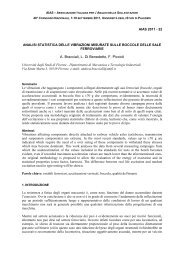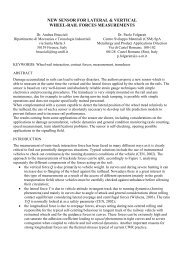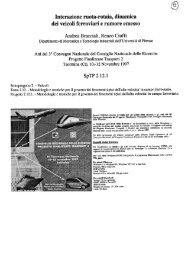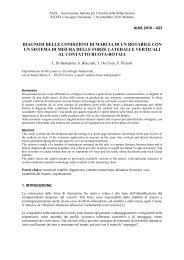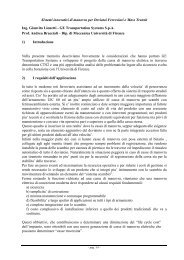LOW NOISE WHEEL - Home page Andrea Bracciali
LOW NOISE WHEEL - Home page Andrea Bracciali
LOW NOISE WHEEL - Home page Andrea Bracciali
You also want an ePaper? Increase the reach of your titles
YUMPU automatically turns print PDFs into web optimized ePapers that Google loves.
2. THE Syope TREATMENT2.1 IntroductionWheel damping can be obtained in several ways, which will not be discussed here. From theliterature it was known at that time that both the track and the vehicle emit significant part ofrolling noise and that the wheel-rail contact patch is able to supply a so-called “rollingdamping” which must be largely exceeded to get a significant reduction of the noise emittedby the wheel.Similarly, as the wheel is only one the components producing noise, the overall noise will bedecreased only by the relevant portion [4]. This makes the use of wheel damping particularlypromising only where track has an intrinsically low-noise formation, and especially at highfrequency and at high speed, where simulations indicated that wheel was the dominant soundradiator.Lucchini identified the well-known constrained layer damping solution as the only feasible as:• the treatment was expected to be automatically approximately equally effective on allwheel eigenmodes, while other treatments need to be ‘tuned’ on the specific wheeleigenmodes. Similarly, the treatment was expected to be relatively independent from thewheel tyre thickness modification after reprofiling, that significantly changes wheelmodes (see a later paper, [5], for a proof of this statement);• the treatment is self-centring and radial centrifugal forces are supported by the metallicpanel and not by polymer, virtually eliminating any stress during the service;• it was expected to possibly apply the treatment to any axial symmetric wheel withoutmodifications to the current geometry, virtually without changing the design and applyingthe treatment to replacement wheel;• the peculiarities of the treatment let suppose that no structural modifications wereintroduced in the wheel and that no safety analysis would have been necessary to beperformed on the treated wheel.At the same time, Lucchini was aware that:• it was necessary to find out a polymer with extremely good properties, considering theexpectations in terms of lifetime in service of a wheel (up to five years) and the extremelydemanding conditions of the railway environment;• the only possible mounting of the wheels on the axle is the press fit one, while shrink (hot)fit normally in use in Italy was not possible as the polymer could not survive to the 200-250° C heating;• the treatment is only possible for disc-braked wheelsets as block braking introduces toomuch heat in the wheel tread that is transferred to the wheel web damaging the polymer.All of these problems were carefully considered and Lucchini started the development of theSyope ® treatment initially as a premium solution for high speed trains. Only after many yearsthe market would have appreciated the product as a valid solution for ordinary service and forlight railways.2.2 Description of the Syope treatmentBasically, the treatment consists of a steel layer constraining a special adhesive polymersheet. The polymer was developed by 3M for aerospace applications and was selected after acareful evaluation of mechanical, chemical and physical properties. Such a polymer based onacrylate technologies has several important features that gave many industrial applications thepossibility to solve not only sound reduction but also bonding aspects and sealing needs.The polymer has a special structure completely homogeneous in every part, this structure hasduring the application process micro movements that fill all the microprofile of the materialsinvolved with a strong improvement in performances also just after a few minutes from theapplication. This aspect can solve also many of the problems due to thermal differentials,especially when the materials bonded together are not the same and then are affected bydifferent contraction or expansion; this is one of the reason of choice in aerospaceapplications where the thermal variation is wide and fast.



